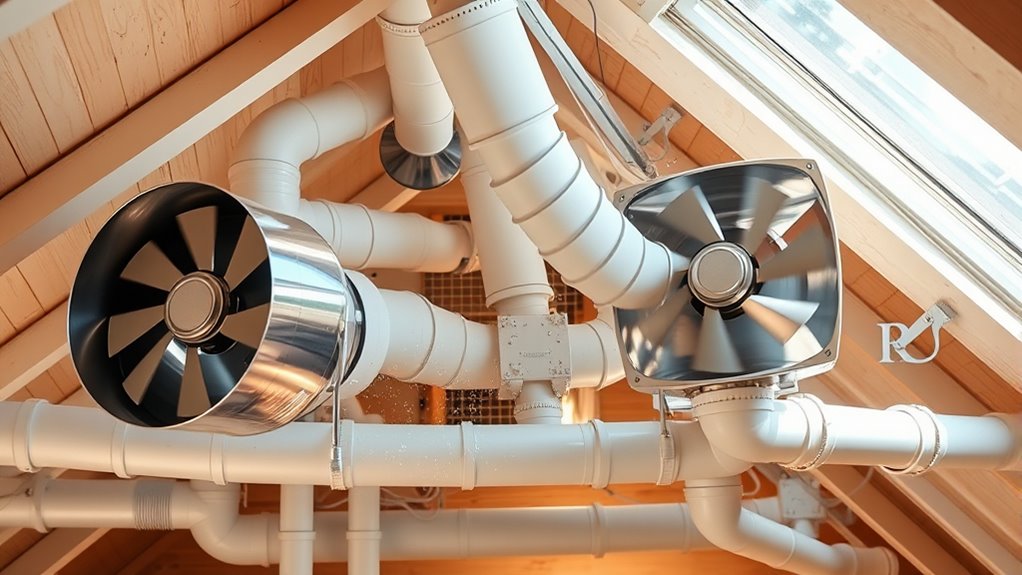To keep your fans and vents working year-round, regularly clean and dust them to prevent debris buildup. Check for obstructions and guarantee vents are unobstructed by furniture or curtains. Replace or clean filters every 1-3 months to improve airflow and air quality. Schedule professional inspections to catch issues early and address any noisy or malfunctioning fans promptly. Continuing this routine helps maintain ideal ventilation—learn more about simple steps to ensure your system’s efficiency all year long.
Key Takeaways
- Regularly inspect and clean vents to prevent dust buildup and ensure unobstructed airflow year-round.
- Change or clean filters every 1-3 months to maintain air quality and system efficiency.
- Keep vents and fans free of obstructions like furniture or curtains for optimal performance.
- Address noisy or malfunctioning fans promptly and seek professional repairs when needed.
- Schedule routine professional inspections to detect duct leaks, mechanical issues, and ensure proper ventilation.

Proper ventilation maintenance is essential for ensuring good indoor air quality and the efficient operation of your HVAC system. When you prioritize airflow optimization, you’re making sure that air moves freely through your vents and fans, reducing the risk of stuffiness, odors, and airborne pollutants. One of the most effective ways to achieve this is through consistent filter maintenance. Dirty or clogged filters restrict airflow, forcing your system to work harder and decreasing overall efficiency. By replacing or cleaning filters regularly, you help maintain ideal airflow, which not only improves air quality but also lowers energy consumption and extends the lifespan of your HVAC components.
Consistent filter maintenance boosts airflow, improves air quality, and extends your HVAC system’s lifespan.
You should check your filters at least once every one to three months, depending on usage and the type of filter you have. If you notice a significant buildup of dust, pet hair, or debris, it’s time for a replacement. Clean filters allow air to pass through more easily, ensuring your fans operate smoothly and your ventilation system stays effective. Neglecting filter maintenance can cause fans to strain, leading to increased wear and tear, higher energy bills, and possible system breakdowns. Make it a habit to inspect filters regularly and swap them out as needed, especially during seasons of heavy use, like winter and summer. Regularly monitoring air quality indicators can also help you determine when filters need attention.
Beyond filter maintenance, you need to pay attention to your vents and fans themselves. Ensure that vents are free of obstructions—things like furniture, curtains, or rugs can block airflow and reduce ventilation efficiency. Regularly dust and clean your vents to prevent dust buildup that can impair airflow and compromise indoor air quality. When fans are noisy or not working properly, it’s often a sign that they need cleaning or repair. Keep blades clean and free of debris, and consider calling a professional if you notice persistent issues. Properly functioning fans and vents work together to circulate fresh air, remove excess humidity, and maintain a comfortable environment year-round.
Additionally, it’s wise to have a routine inspection of your ventilation system by a professional. They can identify issues like duct leaks, blockages, or mechanical faults that you might not notice. A well-maintained ventilation system ensures consistent airflow, which is vital for indoor air quality and energy efficiency. Remember, good ventilation isn’t just about turning on fans and opening vents; it’s about ongoing upkeep—clean filters, unobstructed vents, and properly functioning fans—that keeps your home safe, healthy, and comfortable throughout the year.
Frequently Asked Questions
How Often Should I Replace My Ventilation Filters?
You should replace your ventilation filters based on their filter lifespan, which varies depending on usage and filter type. Generally, a good replacement schedule is every 1 to 3 months. Check the manufacturer’s recommendations and inspect the filters regularly. If they look dirty or clogged, substitute them sooner. Staying on top of this ensures your system runs efficiently and maintains good indoor air quality year-round.
Can Outdoor Weather Affect Vent Performance?
Like the changing seasons paint a mural on your windows, weather impacts your vent’s performance. Seasonal changes can bring humidity, snow, or heat that strain your system, making it less efficient. Weather impact isn’t just temporary; it can cause wear over time. To keep things flowing smoothly, check vents regularly, especially during extreme weather, and make sure they’re clear and functioning well. Stay proactive to protect your home’s air quality year-round.
Are There Eco-Friendly Options for Ventilation Maintenance?
You’re likely wondering if eco-friendly options exist for ventilation maintenance. There are energy-efficient solutions like using low-power fans and sustainable ventilation systems that reduce environmental impact. Regularly cleaning and maintaining vents with eco-friendly products helps guarantee peak performance and longevity. By choosing sustainable ventilation options, you not only cut energy costs but also support a healthier environment, making your home more eco-conscious and efficient year-round.
How Do I Troubleshoot Unusual Fan Noises?
If your fan makes unusual noises, start troubleshooting by checking for fan blade issues, like debris or misalignment, which can cause rattling or squeaking. Listen for motor humming sounds that might indicate a problem with the motor, such as worn bearings or electrical issues. Turn off the fan before inspecting, and clean or tighten parts as needed. If noises persist, consider replacing faulty components or consulting a professional for repairs.
What Are Signs of Ventilation System Failure?
Like a clogged artery, your ventilation system gives warning signs when it’s failing. You might notice reduced airflow, strange odors, or excessive dust. Airflow blockages and duct leaks cause these issues, making your system less effective. If you hear rattling or see inconsistent fan operation, it’s time to check for blockages or leaks. Addressing these signs promptly keeps your system running smoothly and maintains healthy indoor air quality.
Conclusion
By maintaining your fans and vents year-round, you’re opening the windows to fresh air and peace of mind. Imagine your home as a well-tuned orchestra, each component playing its part in harmony. Regular upkeep keeps this symphony running smoothly, preventing chaos and ensuring comfort in every season. Don’t let neglect turn your sanctuary into a rusty, silent instrument—keep your ventilation system singing its sweet, steady tune all year long.









